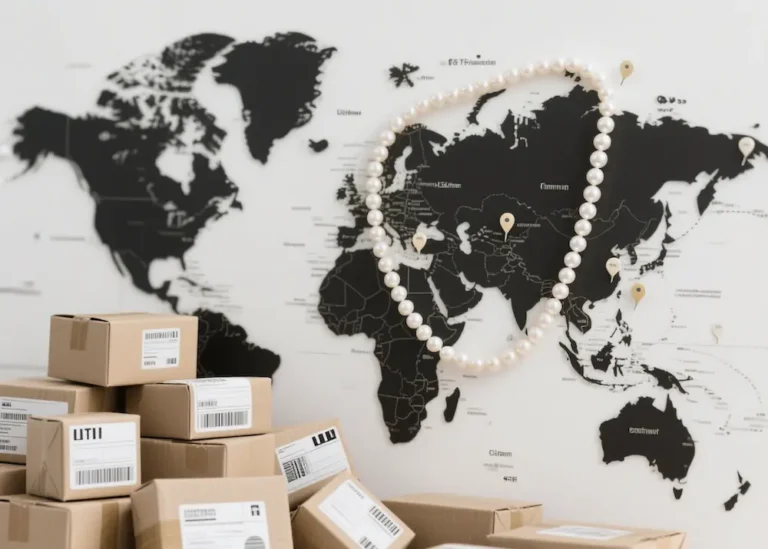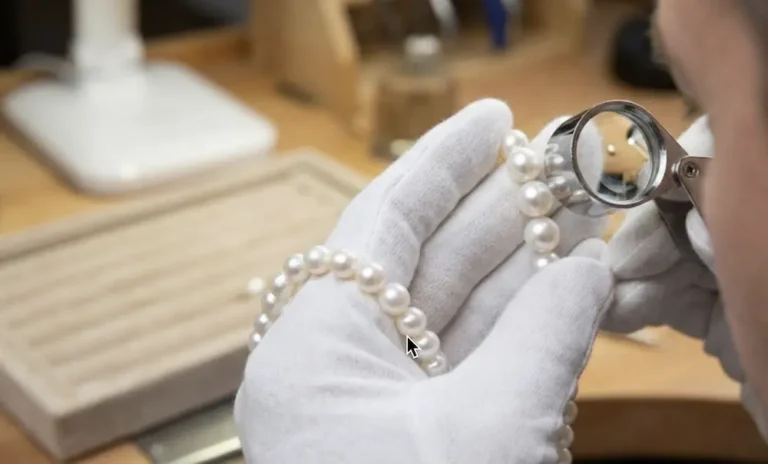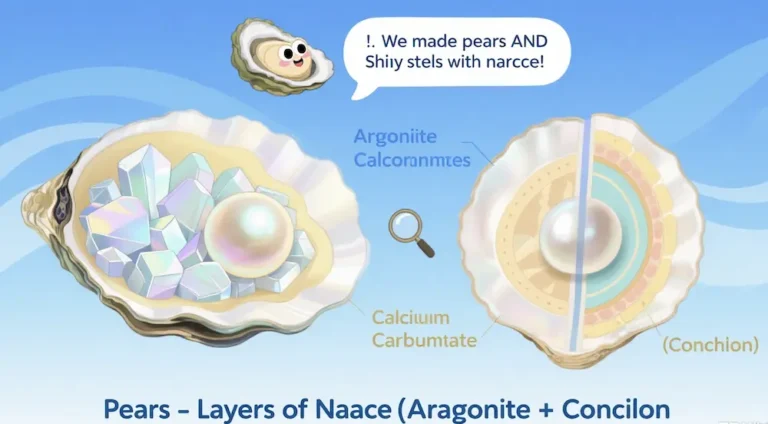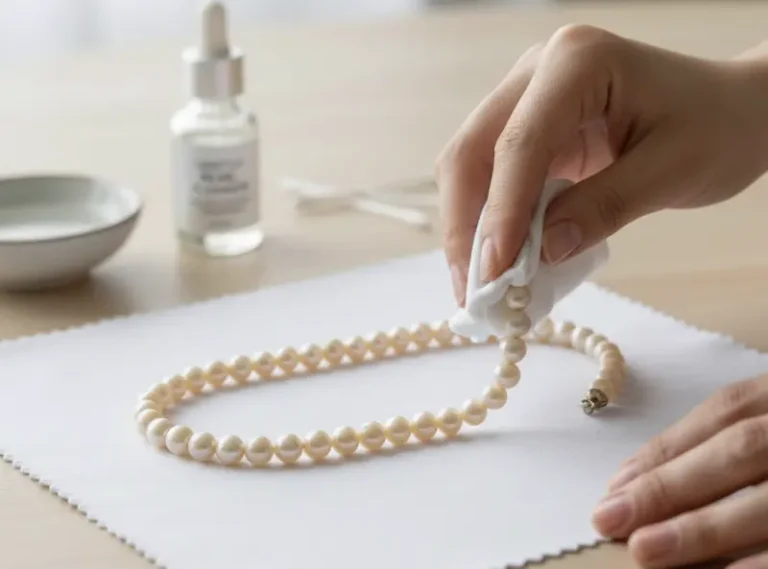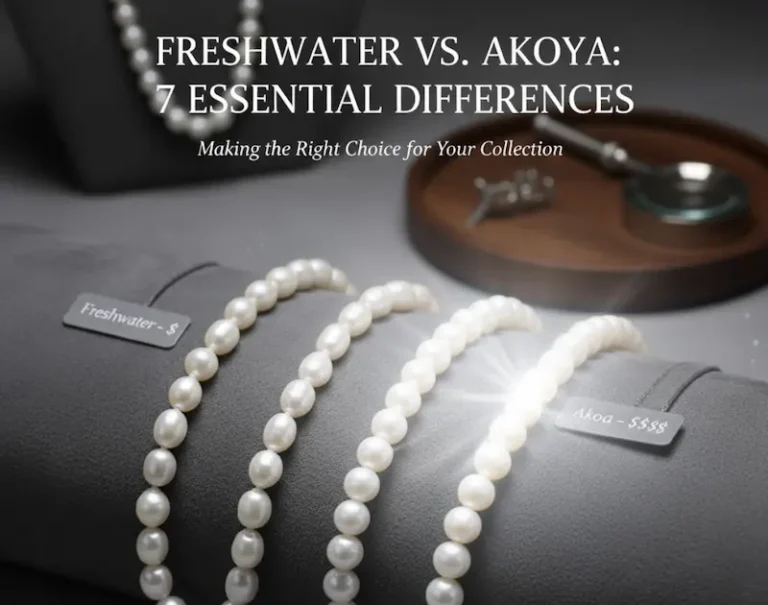Table of Contents
Shopping for high quality freshwater pearls can feel like a minefield, especially when trying to tell a gorgeous gem from something that’s just overpriced. Whether you’re looking for your first pearl necklace or adding to a collection, knowing what makes a freshwater pearl truly special will make shopping way less confusing and way more fun.
Freshwater pearl jewelry are loved around the world because they’re affordable, come in so many varieties, and have a natural beauty. But here’s the thing: not all freshwater pearls are the same. Knowing how to pick out high quality freshwater pearls means paying attention to the little details that separate the stunning ones from the just-okay ones.

This guide will walk you through everything you need to know, from understanding what “luster” really means to spotting tiny flaws that could affect how long your pearls last. By the end, you’ll be able to confidently pick out freshwater pearls that will look amazing for years to come.
Understanding Freshwater Pearl Basics
Before diving into quality factors, let’s get clear on what cultured high quality freshwater pearls actually are. Unlike their saltwater cousins, cultured freshwater pearls grow in lakes, rivers, and ponds – primarily in China, where about 95% of the world’s supply originates.
Before we get into what makes a pearl “good,” let’s quickly talk about what freshwater pearls actually are. Unlike saltwater pearls, freshwater cultured pearls grow in lakes, rivers, and ponds – mostly in China, which produces about 95% of the world’s supply.
When you’re learning how to choose high quality freshwater pearls, you’ll realize they come in an amazing variety of shapes, sizes, and colors. From the classic white and creamy shades to more unique colors like peacock green and deep purple, freshwater pearls offer more choices than any other kind of pearl.
Here’s what makes them different from other kinds of pearls:
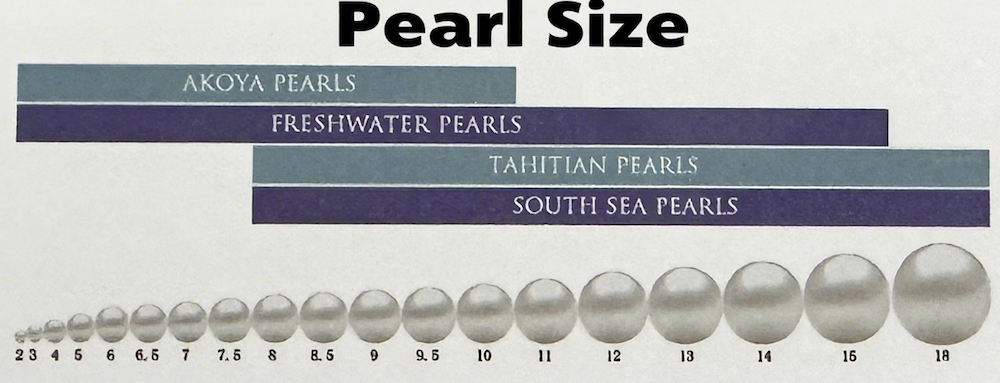
| Pearl Type | Origin | Nacre Composition | Price Range | Color Variety |
|---|---|---|---|---|
| Freshwater | Lakes/Rivers | 100% nacre | $20-$500+ | Extensive (white, pink, peach, lavender, etc.) |
| Akoya | Saltwater | Thin nacre over bead | $100-$2000+ | Limited (white, cream, silver) |
| Tahitian | Saltwater | Medium nacre | $200-$5000+ | Dark colors (black, green, gray) |
| South Sea | Saltwater | Thick nacre | $500-$10000+ | White, gold, silver |
Working with a reputable Pearl Manufacturer ensures you’re getting authentic freshwater pearls with proper quality documentation. Many buyers make the mistake of focusing only on price, but understanding these fundamental differences will help you make smarter purchasing decisions.
The 5 Critical Quality Factors
1. Luster: The Heart of Pearl Beauty
Luster is hands-down the most important factor when determining how to choose high-quality freshwater pearls. It’s that magical glow that makes people stop and stare – the way light bounces off the pearl’s surface and creates depth and brilliance.
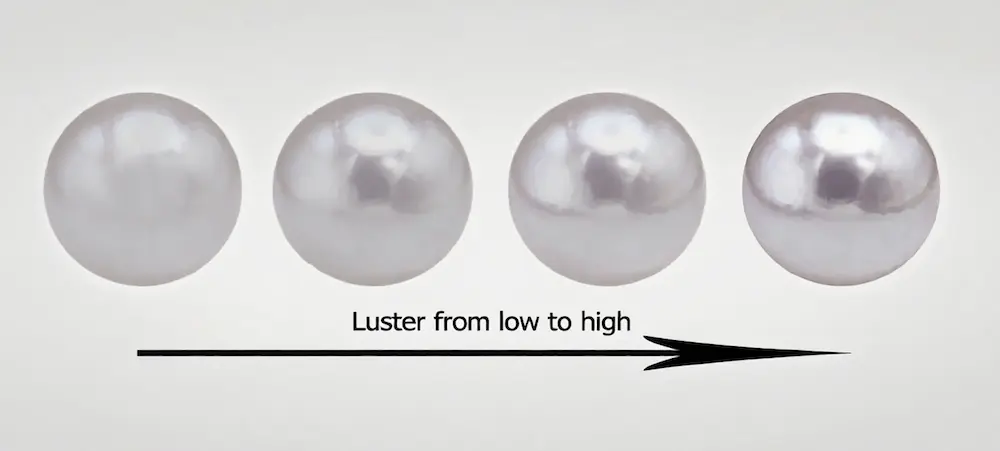
High quality freshwater pearls should have what experts call “mirror-like” luster, a key benchmark in freshwater pearl grading. When you hold the pearl up, you should be able to see your reflection clearly on its surface. If the reflection is blurry or if the pearl looks chalky or dull, you’re looking at lower-grade merchandise.
Pearl professionals grade luster on a scale from Excellent to Poor:
- Excellent: Sharp, bright reflections with good contrast between light and dark areas
- Very Good: Bright reflections with good contrast, slight blurring around edges
- Good: Reflections are somewhat bright but lack sharpness
- Fair: Reflections are weak and blurred
- Poor: Little to no reflection, chalky appearance
2. Surface Quality: Spotting Imperfections
There will always be some small marks or flaws on the surface of even the best high quality freshwater pearls. They’re made by living things, so they’re natural. The key is to know which flaws are fine and which ones mean you should look elsewhere.

Look for these surface features:
- Acceptable: Small pits, wrinkles, or spots that don’t take away from how pretty the pearl is overall.
- Concerning: Deep pits, cracks, chips, or big dark spots that could make the pearl weaker.
- Deal-breakers: Spots where the nacre (the pearl’s coating) is missing, deep scratches, or damage that shows the layers underneath.
When you’re buying pearls in bulk (wholesale), how good the surface looks becomes super important. That’s because you’re buying a lot of them! A tiny imperfection you might not even notice on a single pearl can really stand out when you see it over and over again on a whole string of pearls.
3. Shape: From Perfectly Round to Uniquely Baroque
The shape you like is definitely a matter of personal taste, but it’s good to know that it really affects the price and how you can use them. Round pearls are the most expensive because they’re the hardest to find – only a small percentage (around 5-10%) of freshwater pearls are perfectly round.
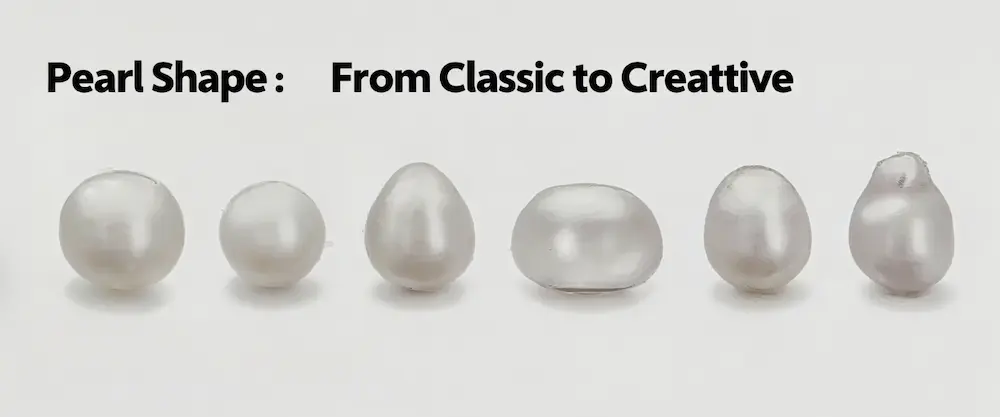
Here’s how different shapes stack up:
| Shape | Rarity | Price Point | Best Used For |
|---|---|---|---|
| Round | Highest | Most expensive | Classic jewelry, formal occasions |
| Near-Round | High | High | Versatile jewelry pieces |
| Oval | Medium | Moderate | Contemporary designs |
| Button | Medium | Moderate | Earrings, casual pieces |
| Baroque | Common | Most affordable | Creative, artistic jewelry |
Don’t automatically rule out those baroque (irregularly shaped) or off-round pearls! Lots of designers actually love these unique shapes because they have so much character and artistic flair. The important thing is to make sure that the wonky shape actually works with what you want to do with them and fits your personal style.
4. Size Matters: Finding Your Perfect Diameter
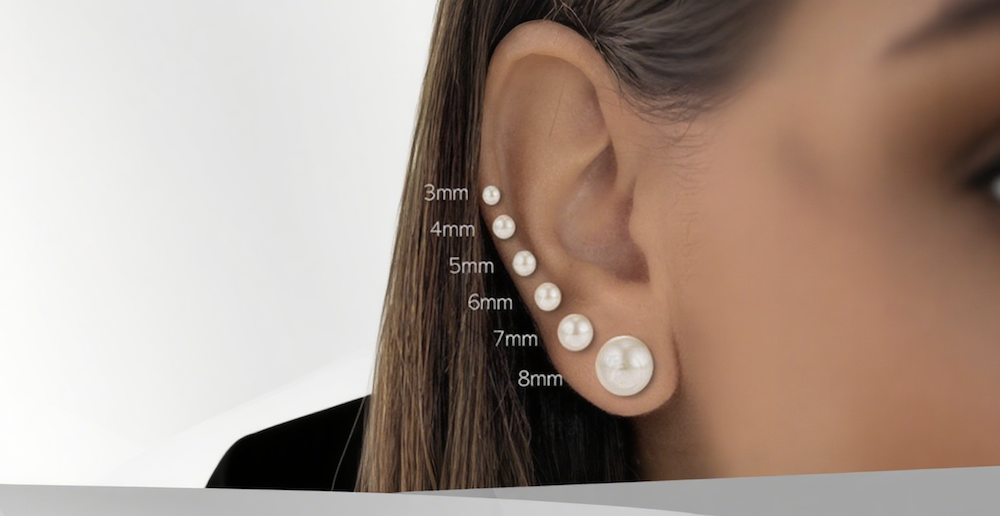
Freshwater pearls come in all sorts of sizes, from tiny little seed pearls (just 2-3mm) to really impressive big ones (15mm or more). Size impacts how much they cost and how easy they are to wear, so really think about what you like and what fits your lifestyle.
Here is a list of common pearl sizes and what they are good for:
- 6–7mm: These are perfect for younger women or anyone who likes a simple, delicate look.
- 7-8mm: This size is the most flexible; you can wear them every day or dress them up for special occasions.
- 8–9 mm: These are a little bolder and make a statement, but they’re still easy to wear.
- 9-10mm: This size is impressive and best for special occasions.
- 10mm+: These are real showstoppers that are sure to get noticed!
5. Color: Beyond Basic White
One of the coolest things about freshwater pearls is all the different colors they come in! You can find them naturally in white, cream, pink, peach, lavender, and even really striking “peacock” shades that have several shimmering colors mixed together.
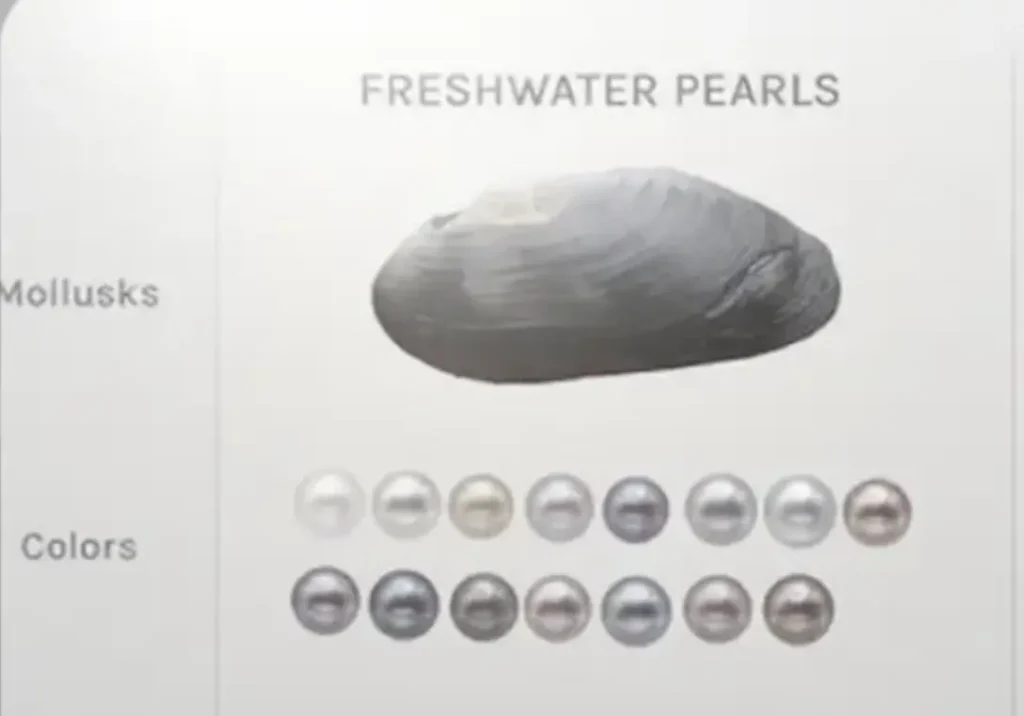
Okay, so when you’re checking out freshwater pearls to see if they’re good quality, here’s what to look for in terms of color in how to choose high quality freshwater pearls:
- Body Color: This is the main, overall color of the pearl.
- Overtone: These are the subtle, shimmering colors that seem to float on top of the main color.
- Uniformity: You want the color to be consistent and even all over the pearl’s surface.
Advanced Selection Techniques
The Reflection Test
To check out the luster (a pearl’s shine), hold it about 6 inches from your face under a good light. You should be able to see your reflection clearly on the surface. If you can actually make out your facial features in the reflection, that’s a sign of a high-quality pearl with great luster. If the reflection is blurry or distorted, the pearl is likely a lower grade.
The Touch Test
A good way to choos high quality freshwater pearl is to hold it. It should feel cool when you first touch it, and then gradually warm up against your skin. Also, it should feel a little heavier than you might expect for its size. That weightiness indicates that it has a thick, good quality nacre.
The Roll Test for Roundness
Here’s a quick and easy way to check how round a high quality freshwater pearl is: Put it on a flat surface and gently roll it around. If it’s perfectly round, it should roll smoothly in any direction. If it’s not perfectly round, or if it’s a baroque pearl (meaning it has an irregular shape), it’ll wobble or roll funny.
Examining Pearl Strands
If you’re buying a pearl strand, there are a few things to look for to make sure they’re good quality:
- Consistent shine (luster): All the pearls in the strand should have a similar level of shine.
- Matching size: The pearls should be very close in size. Ideally, the difference between the smallest and largest shouldn’t be more than half a millimeter.
- Harmonious color: The base colors and any overtones (the subtle colors that shimmer on the surface) should all complement each other nicely.
- Good knotting: There should be a knot tied between each pearl. This protects the pearls from rubbing against each other and also prevents them all from scattering if the strand breaks.
If it’s a graduated strand, make sure the size of the pearls changes smoothly and evenly. The largest pearls should be in the middle, gradually getting smaller as they go towards the clasp.
Avoiding Common Purchasing Mistakes
Mistake #1: Focusing Only on Price
Just so you know, the absolute cheapest option isn’t usually the best deal in the long run. When you’re trying to figure out how to pick out high quality freshwater pearls, keep in mind that super-low prices are often a red flag that suggests the pearls might have:
- Weak shine (luster): They just don’t have that beautiful, reflective glow.
- Lots of blemishes: You’ll see more noticeable imperfections on the surface.
- Odd shapes or sizes: They won’t be as round or uniform.
- A dodgy seller: The seller might not be trustworthy, and you might not be able to return them if you’re not happy.
Mistake #2: Skimping the Setting
Check that the clasp is strong and secure, that the metal is of good quality, and that the whole design really makes the pearls look more beautiful, not less.
Mistake #3: Forgetting about how to take care of them:
To keep freshwater pearls looking their best, they need a little care. When you pick out your pearls, think about how much time and work you’ll need to put into cleaning, storing, and taking care of them.
Mistake #4: Buying Without Documentation
Reputable sellers provide certificates or documentation that detail the pearl’s origin, any treatments it may have undergone, and the qualities that make it valuable. Think of this information as protection for your investment.
Where to Buy: Trusted Sources and Red Flags
Here are some tips for finding reliable pearl sellers:
- Pearl Experts: Companies that only sell pearls usually know more about them and have more choices.
- Certified Gemologists: Look for sellers who are members of groups like the GIA (Gemological Institute of America).
- Exhibitions: At pearl and gem trade shows, you can see and compare the quality of different pearls in person.
- Online Retailers: Pick online stores that have clear return policies, quality guarantees, and lots of information about their products.
Be on the lookout for these red flags when buying pearls:
- Deals That Aren’t Realistic: If a price seems too good to be true, there is probably a catch.
- Unclear Details: Sellers who are honest will tell you a lot about how good the pearls are.
- No Returns: Reputable sellers are confident in their products and will offer returns.
- Pushy Salespeople: Don’t let anyone pressure you into buying something quickly.
The Gemological Institute of America (GIA) says that knowing these quality factors is very important for making smart choices when you buy pearls.
Making Your Final Decision
Look at the big picture after you’ve looked at all the details. The best freshwater pearls for you are those that
- Fit nicely within your budget.
- Match your own personal style and what you plan to use them for.
- Come from a seller you trust, and they have the right paperwork/certifications.
- Wearing them will make you feel great and sure of yourself!
It’s not just about all the technical stuff when you pick out good freshwater pearls. It’s also about finding the pieces you love while making sure they’re good quality.
Care and Maintenance for Longevity
Okay, so you’ve picked out the high quality freshwater pearls – now, let’s talk about taking care of them so they stay beautiful for years to come:
Everyday Stuff:
- Put your pearls on after you’ve done everything else – makeup, perfume, hairspray, the whole deal.
- After you wear them, gently wipe them down with a soft cloth.
- Put them in a different place than your other jewelry so they don’t get scratched..
Deep Cleaning
- Only use a little bit of mild soap and lukewarm water.
- Absolutely no ultrasonic cleaners, steamers, or harsh chemicals!
- If you wear your pearls a lot, get them professionally restrung every year or two.
How to Store Them:
- Keep them in breathable bags, not airtight containers.
- Keep the humidity at a level that won’t dry out and crack the nacre.
- Don’t put any stress on the silk thread by storing them flat.
Investment Value and Future Considerations
High quality freshwater pearls can actually become more valuable over time, especially if they have rare colors, are very big, or are just exceptional in general. If you’re thinking about buying pearls as an investment:
- Choose classic styles that won’t go out of fashion
- Prioritize the highest quality grades you can afford
- Keep all documentation and certificates
- Consider professional appraisals for insurance purposes
Understanding how to choose high quality freshwater pearls positions you to make purchases that provide both immediate enjoyment and potential long-term value.
FAQs
What are the best quality freshwater pearls?
Look for “AAAAA” grade—round, super-bright luster, and clean skin; Edison pearls top the chart.
How much is a real freshwater pearl?
$20–$200 per strand for everyday grades; AAAA, AAAAA can hit $300-1000+.
Which is better, Akoya or mikimoto pearls?
Mikimoto is Akoya—just the brand’s strictest pick; you’re paying extra for their name and flawless sort.
Are freshwater pearls good quality?
Absolutely—modern freshwater pearls are rounder and shinier than ever, giving Akoya a run for less money.
In the end: Selecting exceptional high quality freshwater pearls doesn’t have to be intimidating once you understand the fundamental quality factors. Focus on luster first – it’s the characteristic that most dramatically impacts a pearl’s beauty. Then evaluate surface quality, shape, size, and color based on your personal preferences and intended use.
Take your time, ask questions, and don’t be afraid to compare options from multiple sources. The perfect freshwater pearls are out there waiting for you – armed with this knowledge about how to choose high-quality freshwater pearls, you’re ready to find them.
Whether you’re selecting a simple strand for everyday wear or a statement piece for special occasions, remember that the high quality freshwater pearls are those that make you feel radiant every time you put them on. Trust your instincts, stick to reputable sellers, and enjoy the journey of discovering these remarkable gems of the water.

